#meji period
Text

17yr old Sigi in a butterfly kimono admiring 20yr old Lt Odinkirk in Prussian Blue, and his Hawk Flosshild. - Concept art for Moth volume 1, which is set in Meji period Japan, 1907. Sigi is holding a lantern.
References below.
(Art from the Mononoke Anime Series, and a woodblock print of a Wakashu and his male lover.)


#moth#ottoway#ww1 fiction#original comic#prussian officer#german#japanese#kimono#sigi#siegfried isenstein#vincent odinkirk#meji period#wakashu#mononoke anime#military history#historical fiction#blond male characters#hawk#flosshild the hawk#original art#pet hawk#coloured#concept art#woodblock#flat colours#prussian blue#parade dress#pickelhaube#lieutenant odinkirk
8 notes
·
View notes
Text
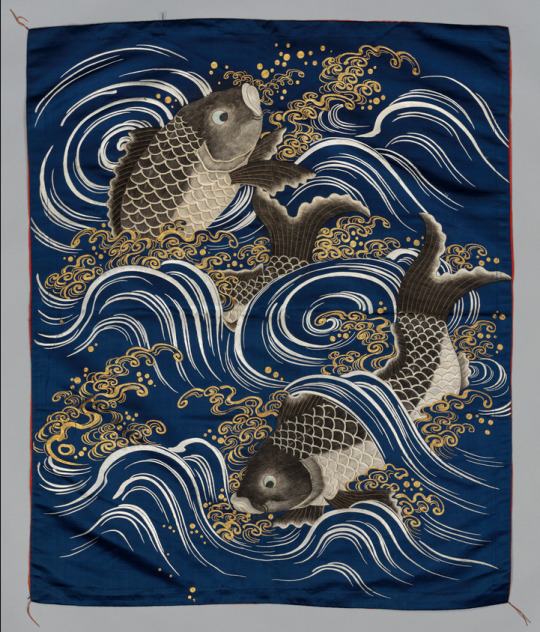
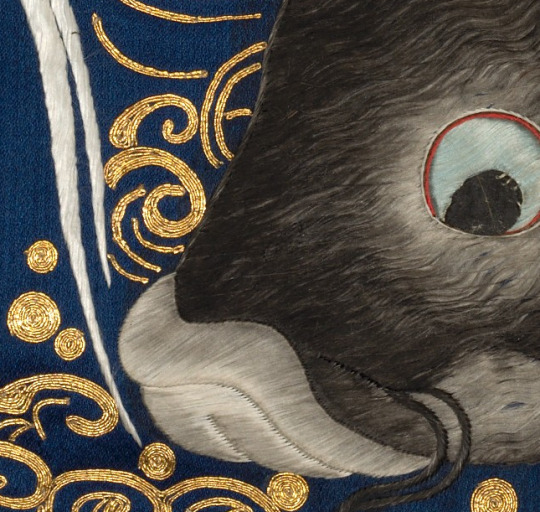


Fukusa with Carp in Waves (波鯉図刺繍袱紗) - details
Gift Cover (Fukusa) with Carp in Waves, 1868–1912. Japan, Meiji period (1868-1912). Silk: embroidered; metallic thread; overall: 87.3 x 71.8 cm (34 3/8 x 28 1/4 in.)
The motif of carp in rough water originated in China. The expression “carp jumping over the Dragon Gate” (liyu tiao longmen) refers to attaining success in life, or, historically, to passing the imperial examinations for civil service. In Japan, therefore, a gift cover (fukusa) like this would have been appropriate to celebrate the recipient’s achievements.
#found by kino#Fukusa with Carp in Waves#japanese embroidery#fukusa#meji period#asian art#textile art#japanese art#波鯉図刺繍袱紗
11 notes
·
View notes
Text
Finally i'm gonna begun the first post in here with my COTL AU
Senso Of The Lamb
I think that'll be the name
Senso(���争) in japanese mean "war" so it also can be call as war of the lamb
It' an AU setting on japan with mixed northeast asian culture that start aroud Heian till Meji period
This au also have full of politics stuff so you can skip if it disturbing
The Land of Old Faith
a beautiful kingdom that got curse by the god
The map is replace in japan world map with a little bit of change

It's also have a Feudal system like
Tenno(emperor got worship like a god)
Shogun(hereditary commander)
Daimyo(feudal leader)
merchant and others
And all of them devide into two side
Ok a lot of wondering let's go to lore and art time
The Shogunate
People who support the shogun side and destroy every single one on their ways
Among of them there are group of person that are the laeder of all they got call as
The Four Heavenly kings
Just four? It's like something is missing
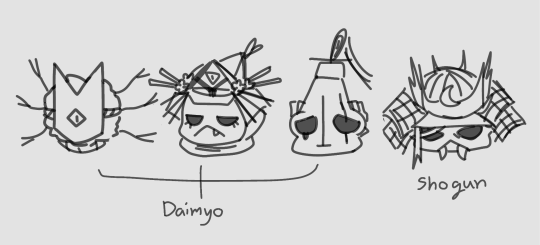
Leshy

Hecket
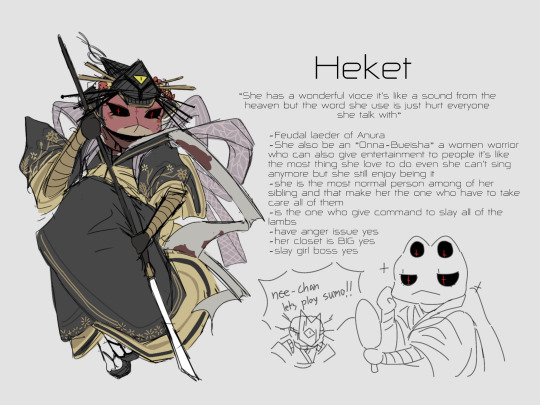
Kallamar

Shamura
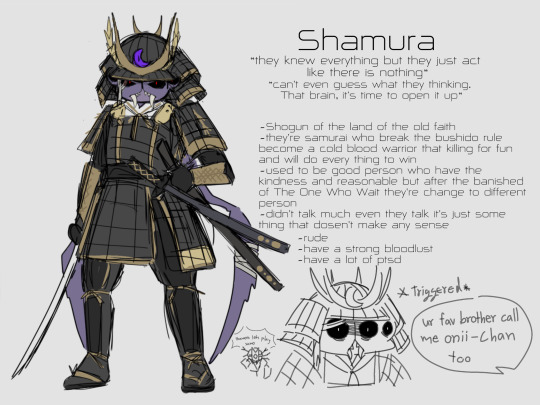
revolutionist
People who resist the shogunate and want to bring back the power to the emperor

There will be more character on this side if i have time to design them lol
Ratau

The Lamb
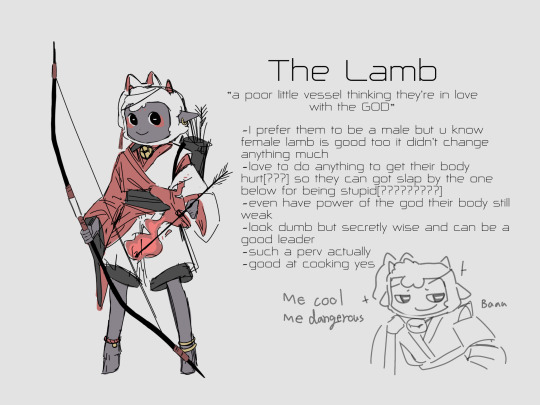
The One Who Waits

I think that's all Storyline on this au didn't have much different from the original but if someone want to know more about stories u can ask me and i will talk about it later
Ps.apologies if its has miss information and lot of mispelling I gonna do more reserch about it
669 notes
·
View notes
Note
Fun fact! When Japan first opened its borders to America and places during the Meji period (which I think is when PLA is meant to be set?), western style clothing was associated with rich people and the elites. Western style uniforms were also reserved for people in governmental roles.
So basically what I'm saying is: the people of Hisui probably think Ingo is loaded or takes his job as a warden a LITTLE too seriously
yeah honestly considering he showed up in Hisui with a super high quality [probably even by our standard considering he runs a major battle facility in Nimbasa] coat and hat + a really fancy wristwatch and pokeballs, I can imagine everyone in Hisui thinking he's royalty or smthn when he showed up
487 notes
·
View notes
Text
Did you know this about the Senju's names?

仏間butsuma: alcove/room where 仏壇butsudan, buddhist altar is placed.
柱間hashirama/space between pillars,bay-> 柱/pillars
扉間tobirama (no meaning) -> 扉/doors(hinges)
瓦間kawarama (no meaning)-> 瓦/roof tiles
板間itama/wooden floor room-> 板/woodenPlanks(flooring)
They end with 間ma/space, room. 板ita/瓦kawara are odd/boring compared to 柱Hashira(symbolic, used for counting kami, pillars/support), 扉Tobira(symbolic, gate to new places/changes)
Ah... but there seems to be a theme...parts of a traditional japanese house/architecture? or temple?
Similar Senju Names: Butsuma's name Mystery
Background: if you remember, Naruto manga was released weekly, Butsuma appeared in ch622 and had a week where he was unnamed. people tried guessing his name, based on pillars/doors/roof tiles/planks theme. Some guessed his name correctly. But naturally you get some silly answers.
Let's learn a few parts of a traditional Japanese house!(mostly end in ma)
梁間harima,etc -> 梁/beams

襖fusuma are opaque/solid sliding doors(ex has black outline, white, but sometimes they have paintings), but 障子shouji are translucent sliding doors with wooden grids. 畳tatami is flooring in traditional house.
欄間ranma(my guess w) are carved/grid "transom window" above sliding doors.

床の間tokonoma(床間) aclove for decorations, sometimes next to 仏間butsuma and often has a 掛軸kakejiku/hangingscroll as decor. 押入れoshiire is built in closet. 地袋jibukuro(red), is ground cupboard. Not the 経机kyouzukue/sutraTable, incense holder in front. Above is a frame of 無量寿/eternal life a reference for AmidaNyorai, important figure in esp. pure land sects.
茶の間chanoma(茶間) originally "tea room" for ceremony, but used like living room. similar to 居間ima, western style.
寝間nema is an old word for bedroom. 寝室shinshitsu or "bedroom" is common modern days.
Joke guess but interesting history
陰間kagema... 陰kage\shadow... "shadow space"...

painting by 鈴木春信SuzukiHarunobu of Kagema(boy prostitute) and customer.
Originally, kagema was a term for Kabuki-in-training boys, who didn't appear in stage,(in shadow space). Young boys(13-20) replaced women roles, and often did prostitution to make ends meet. Later term became synonymous with male prostitute and served men and women customers.
During later Edo period, "pinnacle of sexual passion" was experiencing men and women, so kagema "teahouses" prospered, but eventually faded until meji era's draft/changes which ended prostitution. wikilink
Random: Tsunade and Nawaki
of course Tsunade is a character from the famous goukan, "The Tale of Gallant Jiraya"
綱手tsunade is short for 綱手縄tsunadenawa in the olden days was rope to pull boat back to shore.
Tsunade's brother name in kanji 縄樹nawaki, is "rope tree", 縄nawa is thinner rope than 綱tsuna
Of course Nawaki and Tsunade names, makes me think of shintou practices of 注連縄shimenawa with 四手/紙垂shide wrapped around 神木shinboku/sacred tree, which are used to section off kami's world vs man's world.

Interesting to think about.
#naruto#meta#naruto meta#butsuma senju#tobirama senju#hashirama senju#kawarama senju#itama senju#tsunade#senju#nawaki#naruto fandom#naruto meme#hashirama#tobirama#kawarama#itama#naruto series#butsuma
395 notes
·
View notes
Text

鬼待宵草[Onimatsuyoigusa]
Oenothera jamesii
鬼[Oni] : Ogre, demon
待[Matsu] : To wait
宵[Yoi] : Evening, night
草[-gusa|Kusa] : Grass
One of the evening primroses. Native to North America. It was introduced in the Meji period (1868-1912) and grew wild today.
宵待草[Yoimachigusa] is the same plant as this. In the short story 富嶽百景[Fugaku hyakkei](One Hundred Views of Mount Fuji) by Dazai Osamu, he writes;
"富士には、月見草がよく似合ふ。"
[Fuji niwa tsukimisō ga yoku niau.]
(Fuji is well suited to Tsukimisō.)
It is said that this Tsukimisō(Moon-watching grass) also refers to the evening primrose.
https://www.metmuseum.org/art/collection/search/57794
The flowers bloom at night. I wonder if these flowers I photographed before nightfall today are also blooming now. It is a full moon tonight.
15 notes
·
View notes
Text
Pokémon Day 2024 Predictions Part 1: You Know About Unova
Note: This is ONLY speculation, not official information so take it very lightly.
1. The Black and White Remakes
This is the most obvious ones with all the hints throughout Legends and Scarlet and Violet, specifically the Indigo Disk. But considering the track record of remakes with the recent remake have a more faithful remake with little changes
a. The Same Path HGSS and ORAS
Since many people loved how the remakes of Gold and Silver and Ruby and Sapphire updated their regions, their stories, and characters, this one is more likely to happen. This would possible have the characters having redesigns, a more updated story, and 3D graphics.
b. BDSP like
While BDSP may hated for being well faithful, it still made lots of money and it still has its fans. This seems be the most easiest path.
Fortunately, this means
c. Hybrid
Hear me out on this.
They can do the game with the art style of BDSP but a remixed gameplay with open world elements but with a linear path and
OR
The game can be have the style of scarlet and violet with updated 3D but stay faithful to the beginning and end of Black and White. This doesn’t mean it going have the chibi sprites like in BDSP, but models like Scarlet and Violet and Sword and Shield. As for how the region is structured, it will have a linear path and the same story with little changes.
Hopes:
Have a seasonal selection of clothes if there is any customization for the 4 seasons. Since SV and the Indigo Disk has seasonal options for their uniforms, it may be foreshadowing
Have future characters make cameos or mentions like ones in Paldea and Galar
New Paradox Pokémon like new mega evolutions in ORAS
Having the BB Elite Four appear, especially since Lacey is Clay’s daughter and Drayton is Drayden’s grandson
d. Dual Pack
Due to Unova having 2 games, it
2. Black 3 and White 3
This one is a very thin stretch, since Pokemon haven’t done a threquel to this game. But with how experimental they are going (DLCs, 2nd remakes for Kanto, and Legends) maybe it would be possible.
Hopes:
A new villain due to Ghetsis losing his mind after the events of B2W2
Lacey or Drayton being new gym leaders with Amarys and Crispin making cameos
A new Elite 4 member due to Grimsley retiring or quitting
The Original Dragon finally making a appearance
New player characters
3. Legends Kyurem/Victini
Ever since Legends: Arceus was announced, many people wondered what and how other regions like Unova. And since there’s a lot of myths and legends involving Unova, we could get one focusing on one of those.
While Arceus’s is based on the Meji period of Japan, Unova has to have a one, but which era or period is based is hard to find out.
I’ll give out two fan examples that aren’t mine but are still interesting nonetheless:
youtube
Pokémon Legends: Taroum is a Unovan legends game that is set in the Prohibition Era in the 20s with elements of Detective Noir.
youtube
This example from HoopsandHipHop is inspired by the Colonial era and during American’s separation from Britian. This would be a contrast to Legends Arceus with the player character landing Hisui because of Arceus choose them to find all Pokémon.
Hopes:
The return of the new battle system from Arceus
More survival aspects like in that game as well with your player taking damage during battle like getting poisoned or suffering burns
Hints on or finally seeing the Original Dragon before it split
4. The Release Dates
The Unova games are pretty unique since they have a sequel to the game 2 years later, unlike the usual third version and DLC in Nintendo Switch. So if we are getting the games in the switch, the releases date might be:
Black and White: 2024-2025
Black 2 and White 2: 2026
#pokemon#pokémon#pokemon speculation#pokémon black and white#pokemon sv#Pokémon bw remake#pokemon bw#pokemon legends unova#Pokémon legends kyurem
4 notes
·
View notes
Text
i think quite a bit about periodisation I love that post about cowboys a itinerant warriors from meji era texas great way of exposing the cultural limits of all periodisation like being a medievalist you have to acknowledge that "medieval" is a european paradigm but reading about the history of second temple judaism I realised that as well as "common era" obscuring the reason christian dating have become "common" it is also just the worst to scan (BCE and CE with numbers before them don't scan that different and they only time you need to use CE as a tag is in a piece that will talk about pre christ anyway) and how we need to start accepting all history within its own dating in popular thought more and then allowing people to translate into AD if it's easier for them (I'm doing a short presentation soon relating to islamic history so I will give dating according to the islamic calendar throughout) but also I think we might use periodisation as a way to hold power over times like I've got some books on letter writing from the like 1920s and I was thinking of them in relation to stuff I've read about the byzantines and thought of it was from the later british empire and I think there's something there to being able to make the british empire a period, a thing that has come and gone a whale fall that we need to finish picking clean and repairing the damage of just as we might think of ourselves as thinking of living in the later american empire period because we know this cant continue no empire is immortal though they all believe themselves such
#this is a ramble I don't really have a point#but I like to think#:)#I'm going to be the best historian#they already love me
4 notes
·
View notes
Note
⏳ (YOU ARE BACK ON MY DASH I'VE MISSED YOU)
⏳Do you ever wish you had a mortal lifespan?

"...Back when tatsu-san died...and then his children died...both at old age. Then the Meji restoration happened, and west ideals and systems started shifting through japan like wildfire."
...i felt like I should've gone with the edo period. but I didn't. And I am glad I didn't, but...that did take a while."
2 notes
·
View notes
Text
Catch me writing all of Stone Ocean set in Meji period Japan all because I saw some sexy fanart for Pucci
9 notes
·
View notes
Text

Last night I had a dream about my family buying this giant house from my dead great-grandma, which eventually turned into a what-if scenario of Archie and Maxie as leaders of the Pearl and Diamond clans rather than Aqua and Magma. There was some muddied info about whether each clan were family or not, but just know that the Pearl Clan in my dream were mostly girls in white dresses who didn't talk much, while the Diamond Clan ran more like Team Magma, with Maxie being this business ceo that had to drag at least ten kids around.
During what I'll call the "Mansion Arc," there was a moment of realization Maxie had while meditating with his followers (the more I think about it, the more they seem to be like opposing new age cults, but that's neither here nor there). Cut to a flashfoward that was probably intended to be a flashback: It's nighttime in the woods, and someone is attacked by a man in a mask. Maxie sees this, and goes to help his teammate, and it's revealed that it was Archie all along! He's a ninja!
(Near the end, I was in the lobby of an office building, and after Maxie came in, I got confused and realized that the time-line didn't add-up. I started freaking out, asking what the date was. Someone was like, "the date? I'm not on a date..." and other kept saying, "Uh, I'm not a doctor!" Like, you don't need a doctor to tell you what day it is.)
Anyway, the appearance Shinobi Aogiri/Archie the Pirate Ninja stuck with me, so I did a rough sketch as to what it looked like. The main parts of the outfit that were the clearest was the mask with the gold accessories (rather than on his ear, it's behind it attached to the mask's strap—thought that would be interesting), the bandana (of course), and the sleeveless coat (In the dream, the collar was a lot higher up in the front and had an "M" shape, which I quickly noticed was too similar to Team Magma, so while he was puffing it out to adjust it, it eventually changed). Here, I took those design elements and realized them a bit more, combining both older and modern elements in a concrete manner, utilizing the Pearl Clan's icon over Team Aqua's so that it leans into that Meji-period "look." The pants around the waist was inspired by Brock's Sygna Suit in Pokémon Masters, and I gave him a thick rope for a belt. I also gave him some gloves for some added flair. I think gray, turquoise and the Pearl Clan's colors would make it all work, particularly with the tanned skin of the ORAS design. Sharpedo and Crawdaunt would definitely complement the darker vibes that come with the design and murderous intent that Archie doesn't normally have.
I think I'll clean it up, give the outfit some color and figure out what to do with his right arm.
#pokemon#team aqua#aqua leader archie#pokemon legends arceus#shinobi#aogiri#I actually haven't played PLA yet#I'm playing Alpha Sapphire and Platinum In Japanese first#pirate ninja#ninja#when he needs someone dead he just does it himself#I just realized he doesn’t have his beard XD#Ill see what I can do - no way he's clean-shaven
4 notes
·
View notes
Note
oh, cool! 1, 7 please <3
Top 3 favorite historical periods?
Geesh don't make me decide thats so hard! Uhm
Late 19th century: Victorian Era, Civil war era, german unification, end of industrial revolution, meji restauration in japan ... so much going on...
The twenties: Berlin as the top spot for entertainment, German economical issues in general, peace treaties all over the place, high highs and low lows, rise of the nazi party in many countries (us too and england) then the economic crash... etc
The sixties: Vietnam, student protest, prague spring, rock music, german university students get beat up by police and still continue protesting, student protest everywhere in general (including poland), plus in west germany a change of policy through a new government for the first time since the war
(BUT UGH ALL 20TH CENTURY PERIODS ARE INTERESTING AAA)
7. What is one underrated historical figure you wish was more famous?
I'm not sure, but I feel like I talked to you about her before but: Alice von Battenberg, mother of Prince Philipp (the late husband of the queen.) I just adore her. She was born deaf, which was not great as a princess so she learned to lip read in German, English and later greek. She married a prince of greece and did her very best to support the local population during the Balkan wars (as a nurse!), when her family needed to flee greece she sort of fell into herself and so she said she "Heard god speaking to her" which got her sent to Freud (sigmund freud my beloathed) and she was experimented on, then she returned to greece to work with poor people. During ww2 she hid Greek Jews in her house because the German high command left her alone mostly (due to her being german), she got medicine and food smuggled into the country. Uhm after the war tho her son married the queen of england she stayed in greece, opened and orphanage and used all her money and remaining possesions to finance that above everything else. After the coup she had to leave greece (with heavy heart) and died in england. (also very shortened version)
History asks :3
#ask things#alice von battenberg is just so fucking fascinating really she did so many good things#as far as i know she is the only person of the greek royal family that the modern greeks actually like#philipp and her were seperated when he was just a littl eboy when she was sent to freud and it scarred him for life#ugh anyway
7 notes
·
View notes
Text
Kafka on the Shore
I have read Norwegian Wood, Wind Up Bird Chronicle, Killing Commandatore and Kafka on the Shore shares some similar themes to his other works. Kafka on the Shore was written by Haruki Murakami in 2005. The characters mentioned are Crow, the protagonist named Kafka Tamura, Sakura, Oshima, Nakata, Hoshino, and Miss Saeki. An important part of the story already is “Sometimes fate is like a small sandstorm that keeps changing directions. You change direction but the sandstorm chases you. You turn again, but the storm adjusts. Over and over you play this out like some ominous dance with death just before dawn. Why? Because this storm isn’t something that blew in from far away, something that has nothing to do with you. The storm is you. Something inside of you. So all you can do is give in to it, step right inside the storm, closing your eyes and plugging up your ears so the sand doesn’t get in and walk through it step by step. There’s no sun there, no moon, no direction, no sense of time. Just fine white sand swirling up into the sky like pulverized bones. That’s the kind of sandstorm you need to imagine.” (5) The setting is described as being Shikoku, Takamatsu, Tokyo, and Osaka. The story is about a journey of self discovery and meaning. A quest to find one’s purpose.
In other Murakami books like the Wind up Bird Chronicle and Killing Commendatore, war is discussed like the Sino Japanese war between Japan and China and the Manchurian war. In this story it discusses airplanes dropping bombs in the 1940’s during World War II. Gas was being sprayed to children. The Japanese citizens detested the American soldiers for doing it. Tankas and haikus are discussed because the protagonist Kafka goes into a university and discovers them. The Edo and Meji periods are mentioned. The Edo period lasted from 1603-1867. The Meiji period is from 1868-1912. The Taisho to the early Showa period is discussed too.
There is a philosophical section of the story with a talking cat and an older man. I think they have passed on and are figurative symbols of holiness.
Franz Kafka stories are mentioned like “The Castle”, “The Trial” , ”The Metamorphosis” so I have to see where that leads. Franz Kafka was a postmodernist writer that grew up in Prague Czech Republic.
A teenager is running away from everything that is familiar to him like his father and town and creating a new life for himself in a new town. I think this will be a coming of age novel and self discovery. I enjoy the part of the story with the talking cats. It reminds me of Winnie the Pooh in the magical sense with talking animals. The title Kafka on the shore could be about rebirth and creating a different identity for yourself completely. Starting anew from what you knew. I haven’t read Franz Kafka books so I am not familiar with them. In the story, it talks about killing cats and cutting their heads off. It’s graphic in that way. The character goes to university and learns everything he thought he knew over again. Nothing he knew was right. A passage from the story that I found to be interesting is “A dark, ominous pool of water. It was probably always there, hidden away somewhere. But when the time comes it silently rushes out, chilling every cell in your body. You drown in that cruel flood gasping for breath. You cling to a vent near the ceiling struggling but the air you manage to breathe is dry and burns your throat. Water and thirst cold and heat those supposedly opposite elements combine to assault you. The world is is a huge space but the space that will take you in and it doesn’t have to be very big is nowhere to be found. You seek a voice but what do you get? Silence. You look for silence but guess what? All you hear over and over is the voice of this omen. And sometimes this prophetic voice pushes a secret switch hidden deep inside your brain. Your heart is like a great river after a long spell of rain spilling over its banks. All signposts that once stood on the ground are gone inundated and carried away by that rush of water. And still the rain beats down on the surface of the river. Every time you see a flood like that on the news you tell yourself that’s it. That’s my heart.” (10-11) It is a beautiful passage because to me it could be referencing the flood that ‘God’ brought to earth and people have to deal with it in their own way. The flood is good because it adds new life to things and replenishes figurative and literal “dryness. The passage speaks to the truth in ways because there is a” flood” of everything sometimes and it takes the strong to feel good when one is overwhelmed with things.«1912-1926 was the Taisho period under the emperor Taisho. 1868-1912 was the Meiji period. 1926-1989 is the Showa period. From what I interpret the story to be so far is to be completely letting go of things you know and being open minded to learning things you have never known before and being vulnerable. Being born again and starting afresh in a new universe where everything is a possibility figuratively speaking. Seeing things from a new perspective and new world viewpoint. One book that I know Franz Kafka writes is the metamorphosis about how a person changes and metamorphosizes into a cockroach because he may have “sinned” and that was is fate. After he completes his life as a human, he got reincarnated into a cockroach because he wasn’t a good human being and that was his fate in the next life if one believes in that. I think the story is set in the present day but it references the past with World War Two references. I think reincarnation is a theme in the story because the talking cats could be representative of people’s spirits. It’s a story about a journey. They travel far across highways in Japan to where they need to end up. Leeches are described as falling from the sky in a surreal manner. Fate is a theme. Murakami mentions Oedipus. He mentions Greek mythology in his writing. Kafka on the shore is a song name and the lyrics are “You sit at the edge of the world ,I am in a crater that’s no more. Words without letters Standing in the shadow of the door The moon shines down on a sleeping lizard Little fish rain down from the sky. Outside the window there are soldiers, steeling themselves to die. Kafka sits in a chair by the shore Thinking of the pendulum that moves the world it seems.
3 notes
·
View notes
Text

Machiko said the was the first western bar in Japan - opened during the Meji period..apparently known for a special drink, "brandy
0 notes
Text
Answers to GOA application questions (earlier version)
Please share a link to or a detailed description of a lesson, unit, or learning experience you designed where students practiced one or more of the above competencies. We are particularly interested in experiences that privilege student agency.
I like using Socratic seminar to discuss intriguing and cutting-edge scholarly questions in humanities. At the start of this G9 unit, after getting students hooked on The Needham Puzzle of why and how China had ceded its leadership in Science and Technology to Western countries, I introduced a sub-puzzle in the context of feudal Japan: Why did the Meji Restoration succeed in Japan and the Hundred Days of Reform fail in China?
In the beginning of the semester, a “classroom constitution” that focused on collaboration norms was co-written by all students following a dumbed-down version of one of the Adaptive School protocols. Whenever there was a collaborative issue between students, we would reference the “classroom constitution” which was posted on the wall.
Altogether we watched a video explaining the milestones of the historical event and students were assigned some jigsaw reading materials to familiarize themselves with the context.
To better scaffold the abstract puzzle, several focus areas were given to students: decision-making process in different regimes, cultural similarities vs. differences, environmental determinism (based on geographical features), types of civilization (ocean vs. agricultural), key historical figures (Empress Dowager Cixi, Kang Youwei & Liang Qichao, Guangxu Emperor, Tokugawa Yoshinobu, Sakamoto Ryoma, Saigo Takamori, etc.)
Based on their interests, students chose their focus area under the first-come-first-serve protocol and form research pairs.
With a pre-designed question list and format, students started the research process and continued to do so on the weekend via the collaborative document on Office 365. Students had to use planner tools like Trello to track their research process.
With different roles chosen by students in advance (I modified the roles to questioner, idea proposer, supporter, opposer, paraphraser, recorder/time keeper), they conducted the first Socratic seminar.
In-class and off-class research continued based on the confusion and questions generated in the first seminar.
In the second seminar students were also allowed to use various evidence to corroborate their points, which included but was not limited to visuals and graphs, pictures of artifacts, etc. with a limit of time in order to wrap up the discussion in time.
After the second seminar, students were asked to make a reflective piece based on their choice: podcast, video, written, etc., which formed their portfolio for the later student-led conference too.
If given extra time for the module, I would:
introduce a series of sub-puzzles: for example, why did the tiny Satsuma Domain in southwestern Japan play such a dominant role in Bakumatsu Period?
ask students to write a longer research paper based on different sub-puzzles.
have an exhibition to together tackle the Needham Puzzle and invite real historians as panelists to give students more feedback.
Publish a book titled How G9 Students Tackle The Needham Puzzle and authored by all students in this class!
2. Please describe how and when you give students feedback as a part of the unit/lesson linked above. How do you follow up to see that students have acted on your feedback? Please link to an example of feedback you have given on actual student work. *
Regarding the aforementioned research assignment on comparison of reforms between China and Japan, after the Socratic seminar, I also held individual conferences with each student based on their contribution during the seminar as well as the research memo. During the 1-on-1 conferences, I focused on competencies and asked students to evaluate their targeted competencies first before I gave my opinion. Even during the time when I gave opinion, I used a series of questions to help students verbalize the direction I was hoping for. It is even better the direction turned out to be slightly or completely different from what I visualized depending on student’s input and perspectives, which is the embodiment of emergent learning and collaborative design. It was a Socratic way of offering feedback after Socratic seminar and aligns with the idea of assessment FOR learning in contrast with assessment OF learning.
Currently I’m following the MYP framework in assessment, which is based on criteria. In addition to what I uploaded on ManageBac, I also engaged students in self-assessment and peer assessment after showing them the feedback protocol.
Without the IB constraint, there are a few things I would like to try:
First, I would love to use a collaborative design model for rubrics, which can take fair amount of time but is worthwhile due to the metacognitive gain.
Second, I try to gear towards a more descriptive direction from a more prescriptive direction in terms of giving feedback. If the prescriptive way refers to rigidly following every bullet point of the rubrics, we sometimes find that checking all boxes does not necessarily equal to desired outcome for certain competencies. For example, an argumentative work that piles up all the jargons and follows PEEL structure sometimes doesn’t make sense wholistically. Although it can be argued that this is due to the lack of certain aspect in the rubrics, I still try to start from the student’s work itself, or student as a human being, and link back to the rubrics and competencies, rather than the opposite, especially in the field of humanities. This can be seen as a part vs. whole calibration too.
3. What are you finding most challenging about your current work/position? What are strategies you're using to adapt to/overcome that challenge? *
My current position as head of middle school involves more managerial work than teaching. For the Individual and Society course that I teach, the most challenging thing is that teachers teaching the same course do not have time to meet with each other, especially the Chinese civilization teachers and world civilization teachers. To overcome this challenge, we need to refine the scheduling and staffing model. With my principal position, I had the privilege of initiating a more “focused” teaching assignment model between middle school and high school but it was not easy given my new role and organizational inertia. After bringing key people on board and communication process with a bigger group of faculty, we aim to have most faculty focus on one division for next school year. Therefore we are able to decrease the number of teacher preps and there will be less number of teachers on the co-planning team so they can meet together for next school year.
4. What do you ask for in a collaborator? What do you offer as a collaborator? *
Clarity can be a rare quality and is the first thing I ask for in a collaborator.
As a collaborator, I offer solution-oriented approaches that maximize collective efficacy.
5. If we asked your students to describe you as a teacher, what would they say? *
Knowledgeable and connective: he has “random” knowledge about so many things, especially in the general humanities area, that he can connect with in any module we are learning.
Provocative and challenging: he always said, unlike math and science there is no one correct answer in humanities and he always asks students to disagree with him. He pushes students to disagree with him with all sorts of questioning techniques.
Empowering: he believes in our potentials and continues to push us.
Humble: there are times when he admitted he didn’t know certain things but he would love to create a co-learning experience with the students.
1 note
·
View note
Text
Sankranti Glam: Unleash Your Style with Samyakk's Ethnic Outfits
Makar Sankranti, a significant festival in India, is celebrated to mark the transition of the sun into the zodiac sign of Capricorn. On this important day that holds a special place in our calendar, people all over the country celebrate with excitement and enthusiasm. The festival, known by various names in different regions, holds cultural and historical significance and is celebrated with diverse traditions.
Festive Kaleidoscope: Makar Sankranti’s Cultural Symphony Across India

Makar Sankranti is celebrated with diverse traditions across India, each state bringing its unique charm to the festivities.
In Punjab, it’s celebrated as Lohri, marked by bonfires and vibrant folk dances. People wear colorful Phulkari designer suits, celebrating with bhangra and gidda.
In Gujarat, Uttarayan is celebrated with kite flying, and women adorn themselves in vibrant chaniya cholis.
In Tamil Nadu, signifies the culmination of the harvest season with families coming together to cook the traditional dish ‘Pongal’ and express gratitude for abundance. Pongal involves traditional attire like Pattu Pavadai for women and Veshti for men.
Assam celebrates Magh Bihu, known for community feasts, traditional dances like Bihu, and lighting of Mejis (bonfires). Women wear traditional Assamese attire, the Mekhela Chador, characterized by elegant silk or cotton drapes, while men don Gamosas, traditional handwoven scarves.
These celebrations showcase India’s cultural diversity through distinctive outfits and rituals during Makar Sankranti.
Why is Makar Sankranti Celebrated?
Solar Transition Celebration:
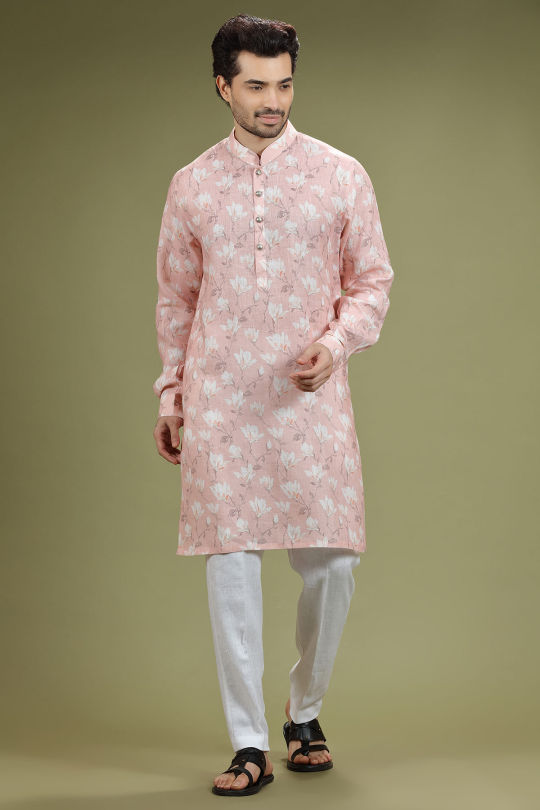
Makar Sankranti marks the end of the winter solstice and the beginning of longer days. As the sun starts its northward journey, symbolizing the arrival of warmer days, the festival signifies the triumph of light over darkness. The word “Makar” refers to the zodiac sign Capricorn, and “Sankranti” signifies the sun’s transition.
Cultural and Harvest Celebrations:
The festival is also closely linked to agrarian traditions, marking the onset of the harvest season. Farmers express gratitude for the bountiful crops and pray for a prosperous agricultural year ahead. The festival fosters a sense of community as people come together to celebrate the abundance of nature.
History of Makar Sankranti:
Ancient Roots:
Makar Sankranti has ancient roots and finds mention in various Hindu scriptures. It is believed that the celebration has been observed for thousands of years, dating back to the Vedic period. The festival is not only a time for religious observances but also a way to celebrate the cyclical nature of the sun and its impact on agriculture.
Religious Significance:
In Hindu mythology, the day of Makar Sankranti is associated with significant events. It is believed that on this day, Lord Surya (the Sun God) visits the house of his son Shani (Saturn), signifying the end of their differences. Devotees take holy dips in rivers and visit temples to offer prayers, seeking blessings for prosperity and well-being.
Special Food During Makar Sankranti:
Sesame and Jaggery Delicacies:
One of the hallmark features of Makar Sankranti is the consumption of sesame and jaggery-based sweets. Til ladoos (sesame seed sweet balls) and gur (jaggery) are often used to prepare various traditional delicacies like til chikki, gajak, and rewri. These foods are not only delicious but also hold nutritional significance, providing warmth during the winter season.
Pongal in South India:
In South India, particularly in Tamil Nadu, the festival is celebrated as Pongal. The signature dish, also called Pongal, is a special rice dish cooked with newly harvested rice, lentils, and jaggery. The act of boiling over of milk during the cooking process is considered auspicious and symbolizes abundance.
Kite Flying Tradition:
Symbolism and Tradition:
One of the most cherished traditions during Makar Sankranti is kite flying. The sky becomes a canvas for colorful kites, creating a breathtaking spectacle. The tradition of flying kites symbolizes breaking free from the past and soaring high with new aspirations. It is believed that the higher the kite flies, the closer it gets to the divine.
Kite Festivals:
Across India, various states organize kite festivals during Makar Sankranti, attracting participants from all walks of life. Cities like Ahmedabad in Gujarat are particularly renowned for their International Kite Festival, where the sky is adorned with kites of all shapes, sizes, and colors. These festivals promote community spirit and friendly competition among participants.
The Allure of Tradition:
Beyond the religious and cultural significance, this festival also provides a unique opportunity to showcase and celebrate India’s diverse fashion heritage. In recent times, the fusion of tradition and modernity has given rise to a trend that blends not only the classic charm of Sarees and Lehengas but also the ethnic allure of designer salwar suits and men’s designer kurtas, creating a fashion statement that resonates with the spirit of Makar Sankranti.
Saree Swagger:
Modern Drapes:
The saree, a timeless piece of clothing, has undergone a remarkable transformation in recent times. Traditionally associated with grace and elegance, the saree has now become a symbol of empowerment and style. The trend of ‘Sari Swagger’ encapsulates the fusion of tradition and modernity, as young individuals experiment with drapes, fabrics, and accessories to redefine the saree’s narrative.
Contemporary Draping Styles:
Traditional designer saree drapes like the Nivi style or the Bengali drape are being reinvented with modern twists. Experimental pleats, quirky twists, and unconventional pallu placements have become a common sight, allowing wearers to express their creativity and individuality.
Fabric Innovation:
The traditional silk sarees are making way for lightweight fabrics like georgette, chiffon, and organza. These fabrics not only enhance comfort but also provide a fresh and breezy look. Handloom sarees from different states are gaining popularity, promoting the rich craftsmanship of Indian weavers.

‘Sari Swagger’ is all about blending cultural influences. The fusion of designer fancy sarees with contemporary designer silk blouses, jackets, or even belts is becoming increasingly common. This blend of traditional and modern elements reflects a dynamic and evolving cultural identity.
Statement Blouses:
The blouse, once a modest accompaniment to the saree, has now become a canvas for artistic expression. Elaborate embroidery, intricate patterns, and bold designs transform the blouse into a statement piece that complements the elegance of the saree.
Contemporary Jewellery:
Traditional jewellery is being reimagined with a modern twist. Kundan, Polki, and temple jewellery are now paired with contemporary designs to create a fusion that effortlessly combines the old and the new.
Footwear Trends:
The choice of footwear plays a crucial role in completing the ‘Sari Swagger’ look. While traditional juttis and mojaris are timeless, contemporary styles like embellished sandals and block heels are gaining popularity, adding a modern edge to the overall appearance.
Lehenga Love:
Experimenting with Silhouettes:
Lehengas, traditionally associated with weddings and special occasions, are now finding a place in the wardrobes of fashion-conscious women for festive events like Sankranti. The ‘Lehenga Love’ trend focuses on experimenting with traditional silhouettes.
Asymmetrical Cuts:
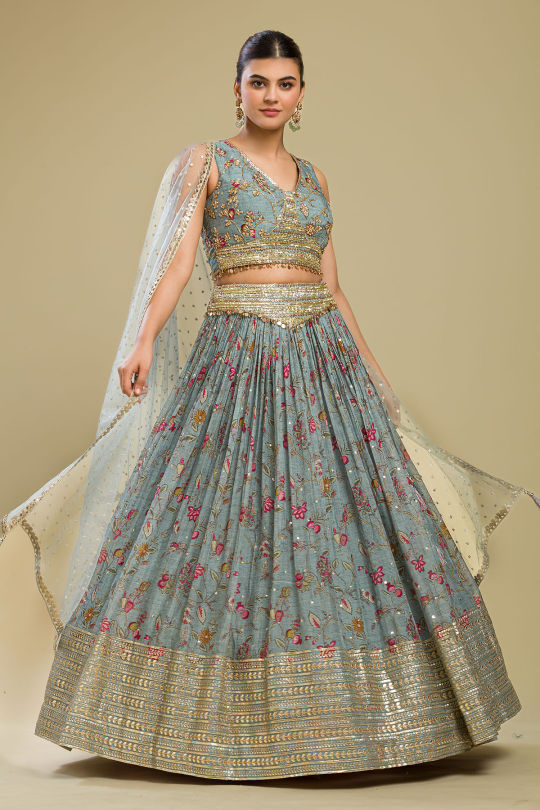
Designer Lehengas are no longer confined to the traditional A-line or flared silhouette. Contemporary designers are experimenting with asymmetrical cuts, mermaid styles, party wear designer lehenga and designer silk jacket lehengas. This experimentation adds a modern touch to the traditional ensemble.
Vibrant Colors and Embellishments:

Makar Sankranti is a festival of colors, and this is reflected in the choice of lehenga colors. Vibrant hues such as mustard, turquoise, and emerald green dominate the designer festive lehenga palette. Intricate embellishments like mirror work, zari, and thread embroidery further elevate the festive vibe.
Salwar Suits for Women:
Comfort and Elegance:

Salwar suits continue to be a popular choice for women during Makar Sankranti festivities. Known for their comfort and elegance, these outfits provide a perfect blend of tradition and modernity. Lightweight fabrics and vibrant colors make designer salwar suits ideal for both religious rituals and festive gatherings.
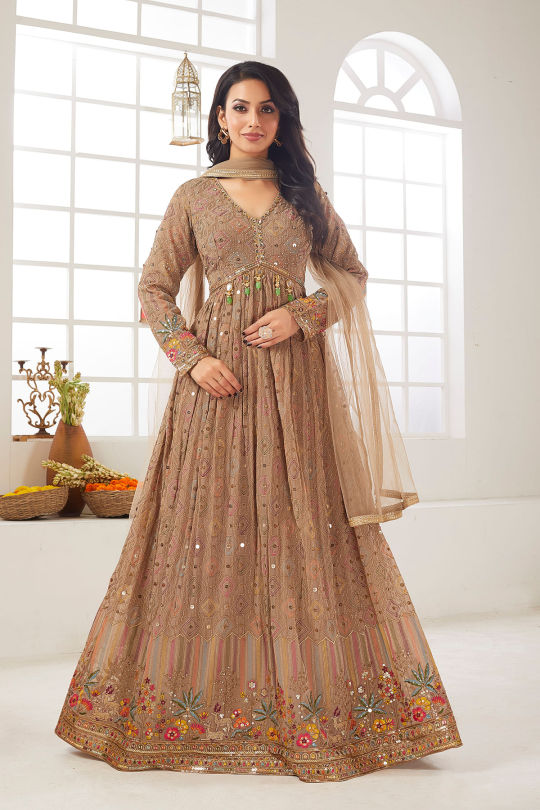
The versatility of festive salwar suits allows for a myriad of designs. From traditional Anarkali suits to contemporary straight-cut suits, designer sharara suit, designer palazzo suits, women can choose styles that suit their preferences. Embroidery, sequins, and mirror work add a festive touch, making salwar suits a go-to option for Makar Sankranti celebrations.
Fusion Styling:
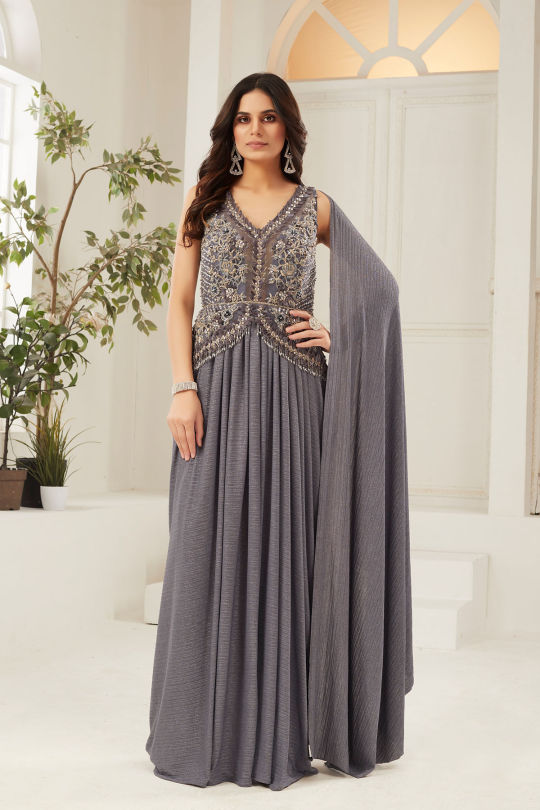
Embracing the trend of fusion fashion, women often pair their ethnic salwar suits with modern accessories. Statement earrings, embellished juttis, or even a contrasting dupatta can elevate the overall look, making it a perfect choice for those who want to experiment with traditional attire.
Men’s Kurta:
Classic Elegance:
Men’s kurtas remain a classic and timeless choice for Makar Sankranti. The simplicity and elegance of a well-fitted kurta, often paired with churidars or straight pants, make it an ideal traditional ensemble. Solid colors or subtle prints are preferred, allowing men to participate in the festivities with sophistication.
Experimentation with Silhouettes:
The evolution of men’s fashion has brought about experimentation with designer kurta outfits. Asymmetrical cuts, shorter or longer lengths, and various neck patterns provide men with the opportunity to showcase their personal style while adhering to traditional aesthetics.
Incorporating Handloom Fabrics:
Handloom fabrics like khaki and silk are gaining popularity in men’s kurtas. These fabrics not only contribute to the rich cultural heritage but also add a touch of luxury to the ensemble. Handwoven details and subtle embellishments enhance the overall appeal, making the kurta a standout choice. Samyakk offers wide range of Kahki Woven Tuxedo suit, Light khaki zaro woven silk kurta, Resham Embroidered Silk Waistcoat kurta, Silk Modi jacket and Multi-color Printed Silk Kurta.
Cultural Impact:
Preserving Tradition:
The fusion of Designer Printed Sarees, Party Wear Lehengas, Plus Size salwar kameez, and men’s party wear silk kurtas during Makar Sankranti harmonizes tradition and modernity, defining vibrant festive fashion. It reflects a broader socio-cultural shift towards embracing and celebrating diversity. The amalgamation of traditional attire with modern elements not only preserves cultural heritage but also allows for a dynamic and inclusive representation of Indian identity.
Revival of Handloom and Indigenous Craft:
The revival of traditional designer outfits, handloom sarees, and ethnic embellishments in contemporary fashion promotes the preservation of cultural heritage. It encourages a sense of pride in one’s roots and contributes to the sustenance of indigenous craftsmanship.
Inclusivity in Fashion:
The acceptance of diverse styles and the breaking of gender norms in fashion demonstrate a growing awareness and acceptance of inclusivity. Fashion is becoming a platform to express individuality, irrespective of gender or cultural background.
Conclusion-
As Makar Sankranti approaches, the convergence of tradition and style takes center stage, epitomized by the fusion of Sarees and Lehengas. This auspicious festival becomes a vibrant canvas for self-expression, where individuals across India showcase a unique blend of cultural richness and contemporary dynamism through their fashion choices.
In this celebratory atmosphere, Samyakk stands as a beacon of choice, offering an extensive collection that includes Kanchipuram sarees, Banarasi sarees, Designer sarees, organza sarees, and an array of lehengas – from Designer and party wear to Bridal lehengas. The brand’s commitment to providing enticing colors, diverse fabrics, and intricate embroideries aligns seamlessly with the festive spirit of Makar Sankranti.
As kites fill the skies, Samyakk invites individuals to soar to new heights of style and individuality, making Makar Sankranti not just a festival but a celebration of fashion, culture, and personal expression.
Wish you all readers a very prosperous makar sankranit from team samyakk.
Written by,
Shaloni Rao
#Saree#sarees#sarees online#online saree shopping#Pattu saree#sarees for wedding#indian wedding sarees#wedding designer sarees#kanjivaram saree#kanjivaram sarees#Kanchipuram saree#Kanchipuram silk saree#kanchipuram saree bridal#kanjivaram saree online#kanjivaram sarees online#kanchipuram silk#kanchipuram pattu sarees#kanchipuram silk sarees#kanjeevaram saree#Kanjeevaram Silk Sarees#bridal kanjivaram saree#kanchipuram saree bride#kanchipuram silk sarees for wedding with price#kanchipuram pattu sarees for wedding#kanchi pattu sarees#kanchipuram sarees#original banarasi saree#banarasi silk sarees#pure banarasi silk saree#Banarasi Silk sarees
0 notes